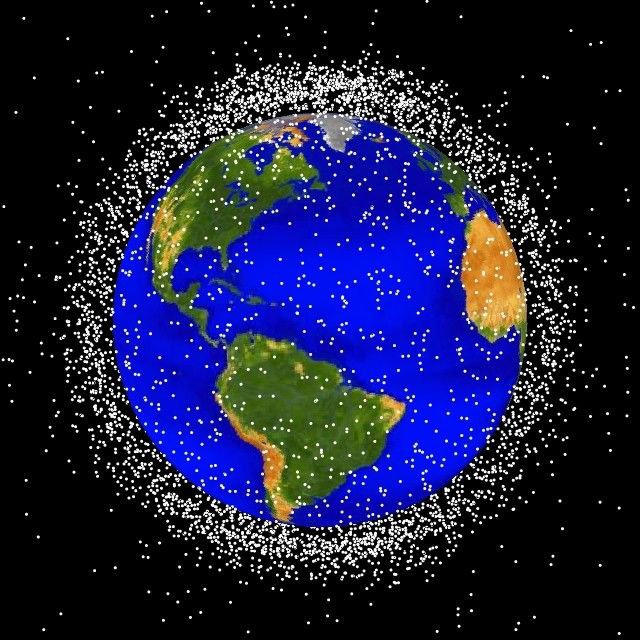
Last week, when I was floating around in space and watching chunks of the Apollo 11 spacecraft drift away below me, I wondered how much other space trash there might be lurking out there in the darkness. I expected for there to be remnants from many space missions hanging around, but the sheer scale of our space littering really surprised me!
Some of the more famous pieces of space debris include a glove that floated away from the Gemini 4 crew during a spacewalk, a camera lost during the Gemini 10 mission, a thermal blanket that drifted away during STS-88, and a spatula that astronaut Piers Sellers lost during Discovery‘s 2006 STS-121 flight to the ISS. "That was my favorite spatch... don't tell the other spatulas," Sellers is reported to have said at the time. Sellers later confirmed that the spatula in question had eventually re-entered the Earth’s atmosphere approximately 4 months later. "NORAD sent me a nice note which had a blue square with an X in the middle of it, and some coordinates," he said, "This was apparently where the ashes of the spatula fell in the Atlantic, about four months after STS-121."
In 2008, astronaut Heide Stefanyshyn-Piper accidentally let a $100,000 tool box drift away from her, as shown in the video below. For months amateur astronomers were able to spot the tool bag in orbit, but eventually in 2009 it too burnt up in the atmosphere. Wikipedia even mentions a lonely toothbrush that is floating through space, although mysteriously I couldn’t find the full story on that one... (If anyone knows, please fill me in!)
However, this is just the tip of the iceberg when it comes to space litter. According to NASA there are millions of man-made objects currently orbiting the Earth, some as large as trucks and some smaller than a flake of paint. The debris is mostly made up of spacecraft parts, fragments of rockets and tiny particles from space collisions or explosions; the tumbling relics of 50 years of space exploration.
When I imagined space debris, I thought of chunks of metal slowly and gracefully pirouetting away into the darkness, never to be seen again, but apparently the average piece of space debris is tearing through space at an incredible 10 km/s, or 35,400km per hour! Check out the gif below to witness the true scale of the space debris encircling us right now. In this clip, the dots have been scaled to make them visible and are not scaled to Earth, and approximately 95% of them are space debris rather than active satellites.

Dangerous Debris
Although Earth’s gravitational field pulls a lot of the slower moving debris into the atmosphere, where it typically burns up upon re-entry, the faster moving debris at higher altitudes can continue to orbit the Earth for centuries. The chief concern with high velocity space debris is the impact damage on spacecraft and active satellites, particularly manned craft such as the International Space Station (ISS). NASA regularly has to replace windows that have been damaged by orbiting flakes of paint! The image below illustrates the damage caused by a tiny chip of paint hitting the STS-35 space shuttle window.
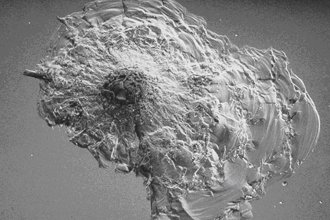
Scientific models estimate that the total number of space debris objects break down to approximately 29,000 objects larger than 10cm, 670,000 objects larger than 1cm, and more than 170 million larger than 1mm. The larger particles of debris (anything bigger than 10cm in diameter) are tracked by the United States Space Command radar, and communicated to satellites and spacecraft (such as the ISS) so that they can alter their course in advance to avoid collisions. Smaller particles (less than 1cm in diameter) will not cause severe damage to spacecraft or satellites, but they still cause minor damage such as scratches and microscopic holes. However, the most problematic debris is the medium sized particles (between 1cm-10cm in diameter), as they are large enough to cause catastrophic damage, but not large enough to be picked up by tracking systems.
“The greatest risk to space missions comes from non-trackable debris” - Nicholas Johnson, NASA chief scientist for orbital debris
Research such as that completed by the Long Duration Exposure Facility (LDEF) help to build our picture of just how many particles there are in orbit and what damage they are capable of. After circling the Earth in low orbit for over 5 years, the school bus sized facility was returned to Earth for examination, and as you can see in the left hand image below, its panel looks like a pin cushion! Likewise, in the right hand image you can see an old panel from the Hubble Space telescope, absolutely covered in tiny impact craters.
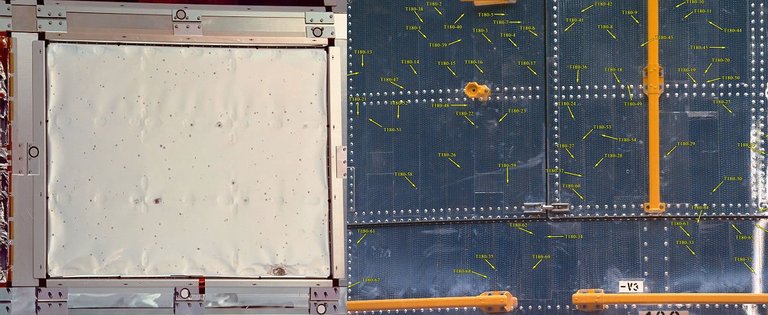
To combat this potential bombardment by untrackable particles travelling at hypervelocities, current spacecraft have to be heavily shielded. The International Space Station is the most heavily shielded craft ever in orbit, particularly around critical areas such as the habitable areas and high-pressure tanks. One type of shielding, pictured below, is known as multishock shielding. It uses many layers of lightweight ceramic fabric, which are designed to shock debris to high enough energy levels that they are vaporised or absorbed before they can even reach a spacecraft’s walls!
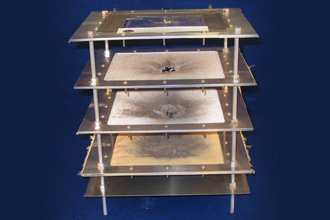
Concern is growing about the escalating creation of space debris, as collisions between existing debris will lead to the creation of even more fragments, causing a runaway chain reaction known as Kessler syndrome. NASA scientist Donald Kessler wrote in 1978 about concerns that the potential for the exponential creation of new space debris caused by collisions could render space activities and the use of satellites infeasible for many generations.
Considering the volume already zipping around up there, it’s surprising that there haven’t been more collisions already. Notable ones in recent history include a French satellite in 1996 that was hit by debris from a French rocket that exploded a decade earlier, and an old Russian satellite that collided with a functioning US satellite in 2009. Adding to the problem, China launched an anti-satellite missile in 2007, which destroyed an old weather satellite and added 3000 additional pieces of space debris to the problem, which later passed within 4 miles of the ISS, narrowly avoiding disaster.
Enter, the Laser Broom
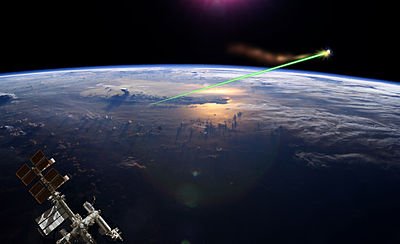
One incredibly sci-fi sounding bit of technology that has been proposed to deal with the medium sized fragments (1cm-10cm) is the multimegawatt land-based laser, also known by its much more humble name, the Laser Broom. The idea is for the laser to heat one side of the debris, adding just enough thrust to change its orbit and send it tumbling into the Earth’s atmosphere to be burnt up. In order for this to work, the laser has to have enough power to penetrate the atmosphere and still have enough power left to ablate material from the target. That’s a seriously strong laser!
In the 1990s NASA launched ‘Project Orion’, which proposed such a laser at a cost of $500 million. However, I struggled to find any follow up on this project, with the most recent research from NASA in 2011 claiming that whilst lasers might be able to alter the course of debris in order to avoid collisions, it would not be possible to cause them to re-enter the atmosphere.
The most recent piece of research I could track down on this kind of technology was a paper published later in 2011 by Claude R. Phipps et al. In this paper, their proposed solution involves the use of a high power pulsed laser system that could make plasma jets on space debris, slowing them enough to cause re-entry and burn up in the atmosphere. The paper involves a reassessment of the recent advancements in mirror and laser design, which lead to their claim that laser removal is the most cost-effective way to reduce the debris problem. They claim that this kind of set up could deorbit dozens of objects per day at a reasonable cost.
However, they emphasise that international cooperation will be essential for creating and operating such a system, something that might be quite tricky when we’re dealing with giant space lasers. Because of the political complications around whether such a laser could be used as a weapon, Kessler states that NASA considers “any laser proposal [to be] dead on arrival.”
So unfortunately it seems like space lasers might be a long way off, but with the problem of space debris ever-increasing, the questions becomes; what are we planning to do instead? The problem is only going to get worse, with tens of thousands of satellites set to launch before 2025, including 12,000 by SpaceX alone! NASA’s Orbital Debris Program Office has set rules that state that all satellites must self-destruct by re-entering the atmosphere by 25 years, but in 2015, 35% did not met these guidelines, largely because it’s expensive, difficult, and the rules are not enforced.
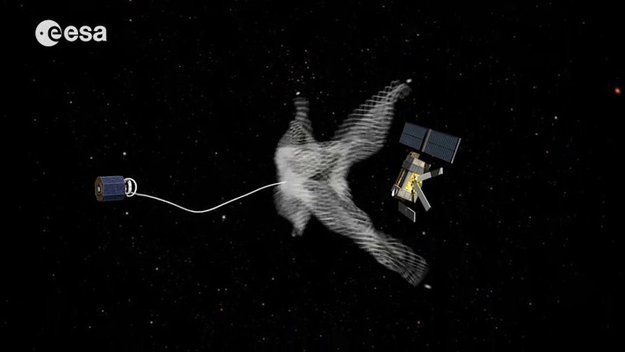
A brief dig around the internet brought all sorts of other solutions to the table; from pushing dead satellites into graveyard orbits, to using the sun as the light source for a giant magnifying glass to vaporise space debris. E.Deorbit, a European Space Agency project, has even proposed missions involving harpooning debris with a tethered harpoon, or capturing it with a giant net or robotic arm!
But, despite the incredible innovations put forward by E.Deorbit, these missions have yet to achieve enough funding and support to launch, which seems quite a big oversight considering the amount of debris piling up around the Earth and the risk this poses the astronauts aboard the ISS. I’ll be keeping a close eye on this for future articles, but in the mean time watch this (trash-filled) space...
Thanks for reading
This post is my own original content. All references and image sources are linked to within the text. This post was also published subsequently on Medium. I will continue to publish similar content in the upcoming weeks, so be sure to follow if you'd like more posts about cosmology, virtual reality, consciousness and philosophy. If you want to follow me elsewhere you can find me at:
Twitter - @ongoingwow
Medium - @ongoingwow
Instagram - @ongoingwow
I personally hope that at least some of these projects to collect the space thrash will work out. This may facilitate the launching of more stuff in space.
Also now, the very strict policies of the space agencies in terms of trash are helpful to avoid making the situation worse.
Thanks for the upvote :) Yeah, also perhaps when they run out of space and they want to launch new things, they'll be forced to do a bit of tidying up!
Congratulations @ongoingwow! You have completed some achievement on Steemit and have been rewarded with new badge(s) :
Click on any badge to view your own Board of Honor on SteemitBoard.
For more information about SteemitBoard, click here
If you no longer want to receive notifications, reply to this comment with the word
STOPuzayda cöp oldugunu düşünmüyorum bu fotografların hiçbiri gercek değildir dünyadan bakınca cok uzaktaki gezegenler gözüküyoda neden 1 tane bile cöp gözükmüyor. Her anlatılana innanmyın.
Possibly inaccurate Google Translate translation: "I do not think there is a garbage in the space, none of these photographs are real. You do not feel welcome to every story."
It would be pretty difficult to photograph much of this debris as much of it is very small and they can be travelling incredibly fast, hence the simulations to give us a better overview. Most of the photographic evidence available online is of the damage this debris causes. Check out this hole caused by debris on Space Shuttle Endeavour!
Congratulations @ongoingwow! You have completed some achievement on Steemit and have been rewarded with new badge(s) :
Click on any badge to view your own Board of Honor on SteemitBoard.
For more information about SteemitBoard, click here
If you no longer want to receive notifications, reply to this comment with the word
STOPCongratulations @ongoingwow! You have completed some achievement on Steemit and have been rewarded with new badge(s) :
Click on any badge to view your own Board of Honor on SteemitBoard.
For more information about SteemitBoard, click here
If you no longer want to receive notifications, reply to this comment with the word
STOPPlease always looking my blog
Loved the post! Space debris is a real problem. Theres a Switzerland-based spaceflight company looking to launch a spacecraft to do some cleaning with the help of Canada. It would essentially grab the space debris in orbit, and then push it towards earth so it would deorbit and burn up in the atmosphere.
Theyre trying to clean up their own debris, there’s a cubesat if theirs that needs to be de orbited as it’s mission life is over. Cool that a space company is cleaning up their own waste!
Slated to launch later this year according this article: https://www.google.com/amp/s/amp.space.com/23049-space-junk-satellite-swiss-space-plane.html
Congratulations @ongoingwow! You have received a personal award!
Click on the badge to view your Board of Honor.
Do not miss the last post from @steemitboard:
Congratulations @ongoingwow! You received a personal award!
You can view your badges on your Steem Board and compare to others on the Steem Ranking
Do not miss the last post from @steemitboard:
Vote for @Steemitboard as a witness to get one more award and increased upvotes!